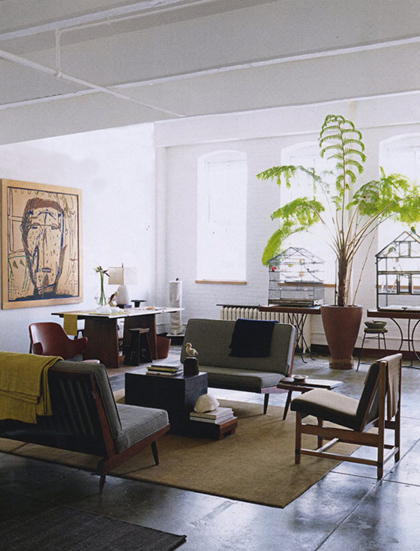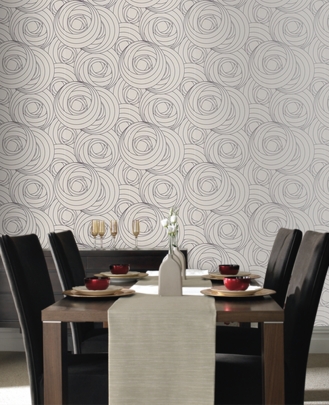
Once again, I am entranced with the dark block table in the middle of an open-plan loft. I haven’t seen anywhere to buy these types of cubes though. I’ve seen white ones at CB2, but no dark-colored blocks. Anyone?
Via Design is Mine.
My goal is to help you find meaningful work, enjoy the heck out of it, and earn more money.

Once again, I am entranced with the dark block table in the middle of an open-plan loft. I haven’t seen anywhere to buy these types of cubes though. I’ve seen white ones at CB2, but no dark-colored blocks. Anyone?
Via Design is Mine.


My mother definitely instilled in me a love for all things Charles Rennie Mackintosh and I would love to put an homage to his infamous roses on my wall.
$40 a roll at Graham & Brown.
“The world needs anger. The world often continues to allow evil because it isn’t angry enough.”
– Bede Jarrett, Dominican Priest

The only season I really care about right now is Spring, but this is such a beautiful and wonderful effort.
Julia Rothman, Lost Bird Found, Deadly Squire, and Oh Joy! collaborated on a set of Four Seasons plates to benefit the relief efforts in Haiti. They each designed one plate illustrating one season for the full set of four. Available for $54 (for the set of 4), 100% of all proceeds are being donating to the Oxfam efforts in Haiti. See more right here.
A little magic to help Katie get dressed in the morning!
via Color Me Katie.
John Besmer confirms our meeting with “Word,” and signs off with, “Yup!” like he’s in the middle of a Jay-Z video. At the corner of corporate and hipster, I arrive to his office to discover him in a plaid button-down shirt, designer-rimmed glasses and a whole lot of Midwestern charm.
I first saw Besmer in a similar uniform on stage. Ten designers shared twenty inspiration slides for twenty seconds each, but Besmer’s stood out; he was the only person to play electric guitar, read from a book and live-tweet during his – he later told me – “horribly lashed-together” presentation.
Besmer, Principal and Creative Director of Planet Propaganda, is one of the creatives that has been paving the way for design to take a front-seat in how we approach everything, from education to careers to business. His client list includes long-standing relationships with big-timers like Jimmy John’s sandwiches and MTV to the young and hip Trek bikes and Red Wing shoes.
“Design is becoming more relevant because things are becoming more complicated” Besmer tells me. And with that, a relative army of people are now claiming the term designer of one sort or another.
Should you need a speedy determination as to whether you’re business or creative-minded, take my test. Ask yourself, what time do I rise and fall? Scoring: Businessmen get up early. Creatives stay up late.
What links designers today “is their belief that everything today is ripe for reinvention and ‘smart recombination’” Warren Berger reports in Glimmer. And such foundational values are the backbone of innovation and business. Here’s how to take advantage:
1. Reframe your job, your tasks, your day-to-day. The concept of job titles are horribly outdated. Accept whatever title you’re given, but expand and burst the borders into far-away corners. Do as designers do and switch up “a familiar problem or challenge [like your job] in an unconventional way…. often the way a problem is framed will determine the solution,” Berger suggests.
Most successful people do this automatically. I know a young lawyer that was just recruited as partner at a prestigious law firm – this, at a time when lawyers are hurting badly – and it’s because he never saw himself as just a lawyer. He was always a leader first, the contracts and depositions came second.
So reframe your career in a new way. Ask stupid questions: Where should I really be living? Could I work from home? If I ate tuna for lunch every day, would that increase my productivity? What makes me happy?
2. Problem-solve to success. “I’m here to help my clients sell stuff,” Besmer tells me, but later admits that problem-solving is what really drives him. When you solve a problem, you get more responsibility, more challenge, new problems to solve. And that is what’s so exciting about successful careers. You solve lots of problems one after the other. It’s the difference between working hard and working smart, between an empty job and a fulfilling one.
Designers are extra good at this since it’s their explicit job description, but problem-solving is really the function of every job, of un-sticking yourself, of true creativity, regardless of the field you’re in – administrative to professional to creative.
3. Gain momentum by doing more and more. Berger reports this is the “’upward spiral’ of solving problems, wherein the more you do it, the more you can do it.” Solving problems, after all, is actually quite daunting and it can be paralyzing to jump in to such high pressure and stress. But once you’re guaranteed the win, it’s just as assuredly guaranteed that you’ll want another one.
“Through constant acts of creative [problem-solving], you also re-create yourself,” Berger continues. “You help propel your own growth spiral, feeding off the energy of creation. That’s not just a feeling, it’s a fact: Being in that state of “design flow’ raises the levels of neurotransmitters in you brain, such as endorphins and dopamine and that keeps you focused and energized.”
My friend Besmer is a testament to such endorphins and energy, and as we wrap up our conversation, he tells me the story of how he moved to a new house a few years ago. He relates that on each moving box, he would write what that box contained. “I’d write ‘old photos, clothes,’ and whatever was actually in the box… then I’d add ‘glass eyes’ just to keep it interesting for the movers. I thought, why not make it interesting for those guys?”
Why not, indeed.
So, how do you make it interesting? Do you work only within the confines of your job title? Are you creative or business-minded?

$495, Etoile Hobo by L.A.M.B.





Are we excited to wear yellow socks? I am excited to wear colorful socks.

I’m quite a fan of Anthroplogie before any ruffles, but this just makes me fall a little harder.
Alexandra Levit has just published the book, New Job, New You: A Guide to Reinventing Yourself in a Bright New Career, which is a great resource if you’re looking for a job or trying to find more happiness in your career. And it got me thinking, one of the myths I see over and over is that job-seekers or those looking to switch careers don’t think they have the skills or experience they need.
What a cop-out.
Of course, any career has a set of knowledge specific to that field. As an architect you probably have some technical knowledge about the size of a door jamb as well as general education about your specialization, like hospitals. But now that you’re ready to move to a new field, you don’t feel you have the gutzpah (experience, skills, knowledge) to apply to that journalism position or get into business development.
Very few employers are actually looking for someone with high level of expertise in a topic, but rather someone who can gain results. This is especially true the higher up the ladder you get. Look at the CEO of Yahoo Carol Bartz who originally came from the AutoCAD industry (architecture and design software).
As an unintentional job-hopper, the next job never hired me because of my body of field knowledge, but my track record of results which is a skill-set suitcase that travels with me and increases (one day, I hope it’s bursting open) to any job.
Those transferable skills are what’s most useful to employers: problem-solving skills, project management, marketing skills, business development, staff management, training and development; communication skills, etc. – and those are what should show up on your resume, how you should talk about yourself when networking, and what to include when writing your cover letter.
New Job, New You goes into great detail on these issues so definitely check it out for a motivating way to start the New Year. In the meantime, I’d love to hear from you:
Could you have any job you want? If not, what’s hindering you or holding you back? Do you have a skill-set suitcase? How do you define it?